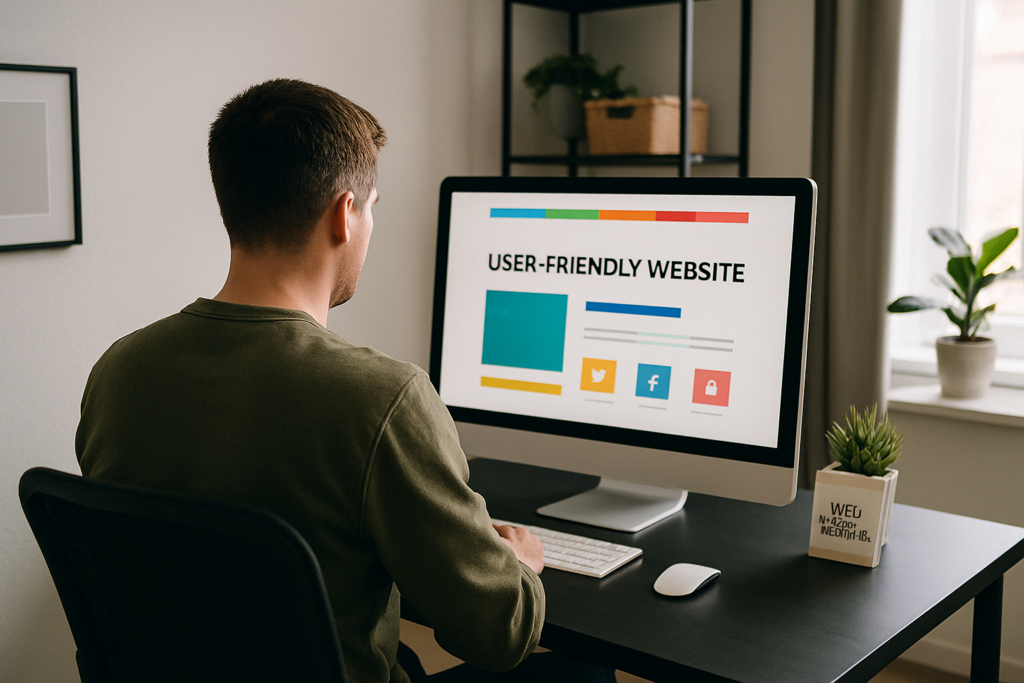Have you ever clicked on a poorly designed website and left within seconds? You’re not alone. Many sites suffer from poor navigation, slow speeds, or cluttered layouts. These common mistakes frustrate visitors and make them leave before exploring your content.
A great website isn’t just about looking good, it must also function well. Modern web design focuses on intuitive navigation, fast load speed, and smooth browsing across multiple devices.
If your site doesn’t adjust to small screens or lacks alt text for images, you risk losing website visitors and harming your site’s credibility.
Even search engines prioritise a seamless user experience. A website that loads quickly, uses a strong colour scheme and follows accessible design standards ranks higher in search results.
Ignoring these factors leads to a poor user experience, lower web traffic, and fewer potential customers. If your site isn’t performing well, it’s time to improve. Keep reading to learn the design mistakes to avoid and how to create a successful website that keeps users engaged.
How Mobile-Unfriendly Design Pushes Visitors Away
Imagine this: you tap a website link on your phone, but the text is tiny, the images don’t fit, and you keep zooming in to click a button. Annoying, right?
This is what happens when website owners neglect mobile-friendly design. With most internet users browsing on mobile devices, a site that fails to adapt loses visitors fast.

The Cost of a Bad Mobile Experience
- Frustrated Users Leave Quickly – If a website is hard to use on small screens, people won’t stay.
- Lost Visibility in Search Results – Search engines favour responsive web design, ranking mobile-friendly sites higher.
- Lower Conversions – A difficult checkout or sign-up process can turn away potential customers.
How to Fix It
- Use Responsive Design – Your site should adapt to all screen sizes and multiple devices.
- Check Mobile Speed – A slow-loading site drives away website visitors and lowers web traffic.
- Prioritise Touch-Friendly Navigation – Make menus, buttons, and forms easy for mobile users to tap.
Navigation Mistakes That Make Users Leave
A website should be easy to explore. When users struggle to find what they need, they leave while reducing user engagement, increasing bounce rates, and hurting search results rankings.
A site with poor navigation frustrates visitors, lowers site performance, and negatively impacts search engine rankings.
1. Complex Menu Structures Confuse Users
Too many menu options overwhelm visitors. Users expect a clear and organised layout that guides them smoothly. If menus are overcrowded, users abandon the site instead of exploring.
Fix It: Keep navigation simple. Use categories and subcategories wisely, ensuring a clean intuitive navigation system.
2. Mobile Navigation Is Often Ignored
Many website owners forget about mobile users. A mobile-friendly site ensures that navigation mistakes don’t drive away visitors. Buttons that are too small or menus that don’t function properly on small screens make for a poor user experience.
Fix It: Design with responsive web design so navigation adapts to multiple devices and screen sizes.
3. Broken Links Frustrate Visitors
Clicking on a page that leads to a 404 error damages a website’s credibility and disrupts a seamless user experience.
Fix It: Regularly check for broken links using tools like Google Analytics.
A recent study by the Australian Government’s Digital Transformation Agency found that 70% of users expect easy navigation and leave if they can’t find what they need within three clicks. Read the full report here.
4. No Search Bar Means Lost Users
Users expect an easy way to locate content. Without a search bar, they may leave rather than struggle to navigate.
Fix It: Add a search function in a visible area to boost user engagement.
5. Crowded Navigation Bars Cause Confusion
When too many options are crammed into a menu, visitors don’t know where to go.
Fix It: Focus on key elements. Use white space to create clarity.
6. Unclear Link Labels Hurt Usability
Links like “Click Here” don’t tell users what to expect. Descriptive link text improves search engine rankings and enhances usability.
Fix It: Be specific and use phrases like “View Web Design Services” instead.
7. Inconsistent Navigation Placement Confuses Users
Navigation should be predictable. When a website has menus in different places across pages, it disrupts the user journey.
Fix It: Keep menus in a consistent location on every page.
8. Poor Accessibility Blocks Users
A successful website works for everyone. Many navigation mistakes come from ignoring web accessibility.
Fix It: Design for screen readers and ensure accessible design practices are followed.
A well-structured website ensures visitors stay longer, interact more, and convert better. Fixing these navigation mistakes helps improve web traffic, strengthens site credibility, and creates a seamless user experience.
Image Mistakes That Hurt SEO and Accessibility

Images play a huge role in modern web design, but many website owners fail to optimise them. Large, uncompressed files slow down site speed while missing alt text makes a poorly designed website inaccessible. These issues lead to a poor user experience, lower user engagement, and weaker rankings in search engines.
According to the University of Queensland, images for the web should be high quality and less than 1MB in size. Larger images cause pages to load slower, affecting your website’s user experience and search engine rankings.
Common Image Mistakes
- No Alt Text – Without alternative text, images are invisible to screen readers and hurt SEO.
- Large File Sizes – Slow loading times damage the seamless user experience and reduce web traffic.
- Wrong File Formats – Using heavy PNGs instead of efficient WebP images.
- Generic Alt Text – Vague descriptions don’t help search results or accessibility.
How to Fix Them
- Write Meaningful Alt Text – Describe images clearly for accessible design and SEO.
- Optimise File Sizes – Compress images for better performance and load speed.
- Choose the Right Formats – Use WebP or JPEG for faster loading.
- Name Files Properly – Descriptive names help brand recognition and searchability.
Font and Readability Mistakes That Ruin User Experience
Reading a website should feel effortless. But poor font sizes, bad colour schemes, and cluttered text make content hard to read. When visitors struggle to scan a page, they leave, hurting user engagement, web traffic, and your site’s credibility.
Common Readability Mistakes
- Small Font Sizes – Text under 16px strains the eyes, especially on small screens.
- Low Contrast Colours – Light grey text on a white background makes reading difficult.
- Too Many Font Styles – Mixing five different fonts makes a website look messy.
- Lack of White Space – Walls of text overwhelm visitors, reducing readability.
How to Improve Readability
| Mistake | Problem | Solution |
| Small font sizes | Hard to read on mobile devices | Use at least 16px |
| Low contrast text | Strains the eyes | Follow WCAG contrast guidelines |
| Fancy fonts | Difficult to scan quickly | Stick to readable typography |
| No white space | Text feels overwhelming | Increase spacing for an organised layout |
Cluttered Pages That Overwhelm Visitors
A website should feel clean and easy to navigate. But when pages are overloaded with text, distracting visual elements, or too many options, visitors feel lost. Hence they leave, reducing web traffic, and damaging the site’s credibility.
What Makes a Page Feel Cluttered?
- Too Much Text – Long, unbroken paragraphs overwhelm readers.
- Excessive Use of Images – Too many visuals slow site speed and distract from key messages.
- No White Space – Without breathing room, the content feels crammed together.
- Flashy Animations – Moving elements can distract rather than enhance user journeys.
How to Make Content Clearer
- Use Bullet Points – Break up long text for easier reading.
- Increase White Space – Allow content to breathe and improve focus.
- Prioritise Key Elements – Highlight the most important information first.
- Limit Animations – Use motion only when necessary.
Slow Websites That Drive Visitors Away
Nobody likes waiting for a website to load. If a page takes more than a few seconds, visitors leave and damage user engagement, reducing web traffic, and lowering search results rankings. Speed tools show that even a one-second delay can cost potential customers.
What Slows a Website Down?
- Large Images – Uncompressed files hurt load speed and delay page rendering.
- Too Many Plugins – Extra scripts slow down site performance.
- Cheap Hosting – Poor servers reduce a site’s credibility.
- No Caching – Every visit loads content from scratch, making pages lag.
How to Improve Load Speed
| Problem | Impact | Solution |
| Large images | Delays loading | Compress files with speed tools |
| Too many plugins | Slows the site | Remove unnecessary ones |
| Weak hosting | Affects reliability | Upgrade for better performance |
| No caching | Reloads everything | Enable browser caching |
A fast website keeps users engaged, improves SEO, and builds trust. Speed isn’t just a technical fix, it’s the difference between gaining or losing visitors.
Final Fixes for a User-Friendly Website

A website should never remain stagnant. Regular improvements help maintain search results rankings, enhance user engagement, and create a seamless user experience.
Many website owners overlook minor yet crucial updates, leading to poor site performance, lower web traffic, and frustrated website visitors. From fixing broken links to improving web accessibility, small changes make a big impact.
One of the most effective ways to improve a successful website is by mastering modern web design principles. Classroom Encounters offers expert-led web design courses that teach essential skills like usability testing, SEO-focused content updates, and performance optimisation using speed tools.
Their training helps site owners enhance brand recognition, create mobile-friendly experiences, and design with user needs in mind.
Keeping your site effective means staying ahead of trends and continuously refining its structure. Investing in the right skills ensures your website meets both search engines’ expectations and visitors’ demands.






